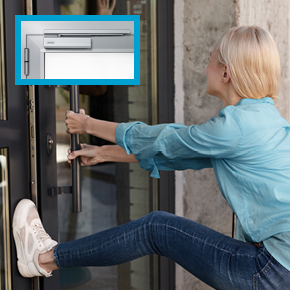
ASSA ABLOY: Choosing the right Door Closer to free your building from unseen barriers
When it comes to access for everyone, no matter their size, age, strength, dexterity or abilities, not every door closer is created equal. Installing the right one — for access through an entrance or interior door — can be the difference between making buildings accessible and simply swapping one barrier for another. ASSA ABLOY has more…
Many countries and international organisations, including the European Union, suggest or enforce accessibility standards for public and private buildings*. In many cases, these regulations apply for specifying both new construction and retrofit projects**.

Installing a door closer is often seen as an ideal solution. The right door closer will ease access through heavy or otherwise awkward openings.
When every important door opens with less effort, building owners offer a more equal experience and encourage participation in the workplace or public life. However, not every door closer will do this job well enough
Four factors to consider when choosing the right door closer
Architects, specification teams, security managers and builders consider many factors before choosing a door closer. From an accessibility point of view, the following four can serve as a useful checklist for improving the inclusiveness of a design:
- Opening force: for genuinely barrier-free accessibility, the force required to open the door should be as low as possible
- Closing force: the door should close fully and automatically, for user convenience, energy efficiency, building security and to comply with fire protection rules
- Closing delay: the final closing section can be a danger point for finger trapping, too quick closing which obstructs users, or damage which could impact performance, so a door closer should be able to adapt to maintain accessibility
- Flexibility: no two doors or buildings are the same, so the door closer should allow variation where feasible in any of the above
Aesthetics is another important consideration. A modern door closer must be discreet, with a contemporary design that blends into its surroundings. It should not make the building look like an ‘institution’.
Barrier-free access: let Cam-Motion® technology do the work
Door Closers with ASSA ABLOY’s Cam-Motion technology provide ergonomic opening for everyone who passes through them. Unlike traditional rack-and-pinion door closers, Cam-Motion Door Closers with guiderails require a push-force that falls rapidly. Cam-Motion mirrors the power of a human elbow, where torque also reduces sharply as the arm extends. This translates into much easier opening and greater comfort.
ASSA ABLOY Door Closers offer optional closing delay, which allows extra time for any user to pass through the door. To protect the frame and prevent banging into walls, the back-check function as standard across the range slows the door’s final opening section before shutting tight. They are tested to meet EN 1154 standard for fire and smoke protection and fulfil barrier-free building requirements.
Cam-Motion Door Closers maximise flexibility without impacting their accessibility benefits. Their design allows fitting to either frame or door, and on hinge or non-hinge side: Whatever suits the opening best. They can equip both single- and double-leaf doors.
Cam-Motion technology is designed with independent valves, enabling separate latch and closing speeds to be set, so closing performance meets the door’s specific use. These valves are thermo-resistant: Once door speeds are set, they stay set — even at extreme temperatures.
Andreas Gmelin, Product Management and Business Development Director, EMEIA Door Closer Product Unit at ASSA ABLOY Opening Solutions, comments: “In meeting all these important accessibility criteria, Cam-Motion Door Closers do not sacrifice any durability. Door Closers are often deployed at a building’s busiest doors. They need to be tough.”
To learn more about the accessibility benefits of an ASSA ABLOY Door Closer, visit https://campaigns.assaabloyopeningsolutions.eu/doorclosers
Sources
*: www.cencenelec.eu/news-and-events/news/2021/eninthespotlight/2021-03-18-en-17210-2021-accessible-and-
usable-built-environment
**: https://fra.europa.eu/en/content/are-there-mandatory-accessibility-standards-national-and-local-authority-
buildings
Contact ASSA ABLOY Opening Solutions EMEA Digital and Access Solutions
Dukes Court/Dukes Street
Woking
GU21 5BH
United Kingdom
Web: About us | ASSA ABLOY
Email: Thomas.schulz@assaabloy.com
Phone: 0049 30 8106 2970
Visit Supplier's page
Latest news

28th March 2025
Ideal Heating Commercial announces 10-year warranty on Evomax 2 boiler
Evomax 2, the UK’s number one selling commercial wall-mounted boiler from Ideal Heating Commercial, is now available with a 10-year warranty.
Posted in Articles, Building Industry News, Building Products & Structures, Building Regulations & Accreditations, Building Services, Facility Management & Building Services, Heating Systems, Controls and Management, Heating, Ventilation and Air Conditioning - HVAC, Innovations & New Products, Pipes, Pipes & Fittings, Plumbing, Retrofit & Renovation, Sustainability & Energy Efficiency, Videos
28th March 2025
FLIR Si1-LD Acoustic Imaging Camera for Compressed Air Leak Detection
FLIR, a Teledyne Technologies company, introduces the Si1-LD, an industrial acoustic imaging camera that brings faster and more accurate compressed air leak detection to those operating on a modest condition monitoring budget.
Posted in Acoustics, Noise & Vibration Control, Articles, Building Industry News, Building Products & Structures, Building Services, Facility Management & Building Services, Information Technology, Innovations & New Products, Retrofit & Renovation, Sustainability & Energy Efficiency, Thermal Imaging and Monitors
28th March 2025
LIFTEX 2025 Seminar programme announced
Registration has opened for LIFTEX 2025. Now in its 37th year, LIFTEX 2025 is the UK’s only dedicated exhibition for the lift, escalator and access industry and takes place only once every three years.
Posted in Access Control & Door Entry Systems, Accessibility, Articles, Building Industry Events, Building Industry News, Building Products & Structures, Building Regulations & Accreditations, Building Services, Exhibitions and Conferences, Facility Management & Building Services, Health & Safety, Retrofit & Renovation, Security and Fire Protection, Seminars
28th March 2025
MCRMA welcomes ArcelorMittal UK to membership
A UK division of the global steelmaking business ArcelorMittal has become the latest new member of the MCRMA, the industry association representing the metal building envelope sector.
Posted in Articles, Building Associations & Institutes, Building Industry News, Building Products & Structures, Building Systems, Cladding, Facades, Posts, Restoration & Refurbishment, Retrofit & Renovation, Roofs, Steel and Structural Frames, Walls
 Sign up:
Sign up: